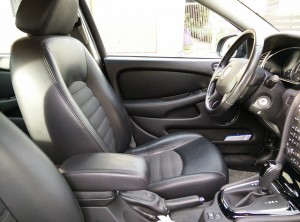 Print a Sign-In Sheet | Spanish Version
Print a Sign-In Sheet | Spanish Version
Seat Adjustment:
- To judge legroom, with your hands evenly placed on the steering wheel, you should be able to see equal amounts of both legs between the arms. If you can see the left leg, but not the right, this can result in rotating the pelvis when driving, which can cause more pain.
- There should be room for your fist between the crown of your head and the top of the car. If there is only room to put your flat hand between the top of your head and the roof, the car is definitely not offering enough head room for you and you will slouch in the seat, straining the back and thighs. Is the backrest angle made to be in either an upright or reclined position?
- Adjust the headrest so the top is even with your eyes. This is the optimal position for support and helps prevent neck injuries in an accident.
- Height adjustment for armrests is ideal, but often hard to find.
- A seat with an inflatable lumbar support is ideal. You can adjust it to the perfect position for your comfort.
What you can do:
- Change your posture from time to time. Wait until driving conditions are suitable to allow you to wriggle in the seat to alleviate postural fatigue.
- Take breaks. Success does not depend on beating the land speed record your brother currently holds for the same trip.
- On any trip, don’t go directly to sitting in a restaurant and back to the car without stretching or going for a walk.
- Sheepskin covers can provide comfort and cushion for the trip.
- You can buy many kinds of seat cushions for comfort.
- Beaded covers are said to massage the back as you drive.
- Keep your pelvis higher than your knees for the optimal comfort position.
- Keep your knees and thighs at the same level.
- Keep your legs uncrossed.
- Maintain the natural curves of your back during all activities.
- Use proper lifting techniques and body mechanics.
KEMI does not assume liability for the content of information contained herein. Safety and health remain your responsibility. This information is to be used for informational purposes only and not intended to be exhaustive or a substitute for proper training, supervision or manufacturers’ instructions/recommendations. KEMI, by publication of this information, does not assume liability for damage or injury arising from reliance upon it. Compliance with this information is not a guarantee or warranty that you will be in conformity with any laws or regulations nor does it ensure the absolute safety of any person, place or object, including, but not limited to, you, your occupation, employees, customers or place of business.

